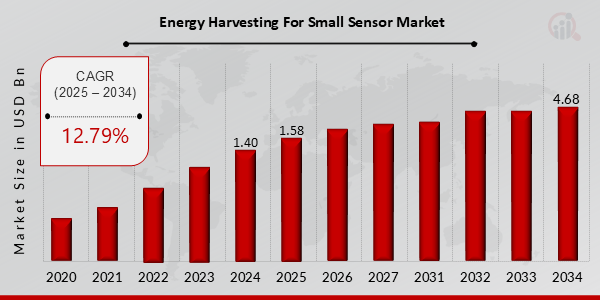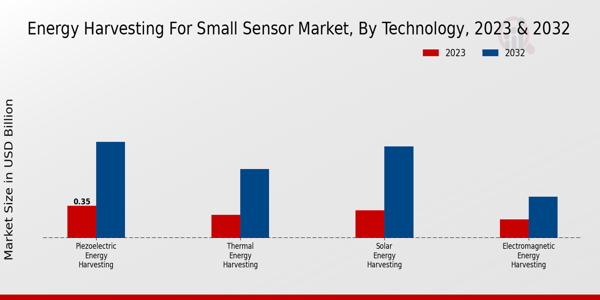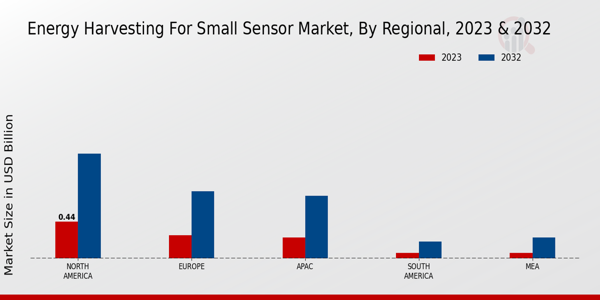Global Energy Harvesting for Small Sensor Market Overview:
Energy Harvesting For Small Sensor Market Size was estimated at 1.40 (USD Billion) in 2024. The Energy Harvesting For Small Sensor Market Industry is expected to grow from 1.58 (USD Billion) in 2025 to 4.68 (USD Billion) till 2034, exhibiting a compound annual growth rate (CAGR) of 12.79% during the forecast period (2025 - 2034)
Key Energy Harvesting for Small Sensor Market Trends Highlighted
The Energy Harvesting for Small Sensor Market is driven by a growing need for sustainable energy solutions, particularly in the Internet of Things (IoT) sector. Increasing adoption of smart devices and wearables has spurred demand for energy-efficient sensors that can operate without frequent battery changes. This quest for uninterrupted power supply in remote and inaccessible locations makes energy harvesting technologies appealing. Furthermore, regulatory pressures for reducing carbon footprints and enhancing energy efficiency contribute to market growth. Innovations in materials and technologies also play a significant role in enhancing efficiency and cost-effectiveness, attracting both manufacturers and consumers.
There are numerous opportunities to be captured in this evolving market landscape. The continued advancement of wireless sensor networks offers a promising avenue for integrating energy harvesting solutions. Industries such as healthcare, agriculture, and manufacturing are increasingly recognizing the potential of these technologies to optimize operations and reduce energy costs. Additionally, the rise of smart cities creates a demand for sensors that can monitor urban infrastructure, providing another platform for energy harvesting applications.
Investing in research and development may lead to innovative solutions that address challenges like energy storage and conversion efficiency, further opening up potential avenues for growth.Recent times have witnessed a trend towards miniaturization and enhanced efficiency in energy harvesting technologies, making them more suitable for small sensors. The development of flexible energy harvesting devices is also gaining traction, allowing for applications in unconventional spaces and surfaces. This adaptability not only expands the functional scope of energy harvesting solutions but also makes them more user-friendly.
Overall, as market participants tap into these trends and opportunities, the future of the Energy Harvesting for Small Sensor Market looks promising, with continuous innovation poised to drive its evolution.

Source: Primary Research, Secondary Research, MRFR Database and Analyst Review
Energy Harvesting for Small Sensor Market Drivers
Increasing Demand for Wireless Sensor Networks
The Energy Harvesting for Small Sensor Market Industry is primarily driven by the increasing demand for wireless sensor networks. As the Internet of Things (IoT) continues to gain traction across various sectors such as healthcare, agriculture, manufacturing, and smart cities, there is a growing need for reliable and efficient power sources to sustain sensor operations. Wireless sensors are critical in numerous applications including environmental monitoring, predictive maintenance, and smart home automation.These sensors often require continuous power supply, and energy harvesting solutions enable the maintenance of sensor networks without the need for frequent battery replacements.
This not only enhances the reliability of the sensor systems but also significantly reduces maintenance costs and operational disruptions in the long run. Furthermore, the push towards automation and real-time data analytics in various industries highlights the importance of energy-efficient sensors that operate independently from traditional power sources.The ability to harness energy from ambient sources such as light, heat, and motion makes energy harvesting technologies highly attractive for powering small sensors, thereby driving the overall market growth.
Additionally, advancements in energy harvesting technologies, along with increasing investments by governments and private sectors in smart infrastructure and IoT applications, are expected to further propel the Energy Harvesting for Small Sensor Market Industry forward.
Technological Advancements in Energy Harvesting
Technological advancements in energy harvesting methods significantly contribute to the growth of the Energy Harvesting for Small Sensor Market Industry. Innovations in materials science and engineering have led to the development of more efficient energy harvesting devices that can convert ambient energy into usable electrical power. Techniques such as piezoelectric materials, thermoelectric generators, and photovoltaic cells have seen dramatic improvements, allowing for higher energy conversion efficiencies.
This increased efficiency opens up new possibilities for applications in remote sensing, wearable technology, and other areas where small sensors play a vital role. With better designs and more robust systems, energy harvesting technologies are becoming more viable for mass production, which, in turn, leads to cost reductions for end-users. As the demand for energy-efficient solutions rises, the adoption of these advanced energy harvesting systems is anticipated to escalate, thereby boosting market growth.
Environmental Sustainability Concerns
The growing focus on environmental sustainability and reducing carbon footprints drives the Energy Harvesting for Small Sensor Market Industry. With increasing awareness of climate change and its impacts, there is a concerted effort across industries to implement green technologies and sustainable practices.
Energy harvesting solutions offer a path to energy independence and lower environmental impact since they utilize renewable resources, thereby minimizing reliance on conventional batteries that can have detrimental effects on the environment.This shift towards sustainable energy solutions reflects a broader trend in the market, as companies and consumers seek to adopt practices that contribute positively to environmental stewardship. The adoption of energy harvesting technologies not only aligns with global sustainability goals but also satisfies regulatory pressures to reduce environmental impacts, making it a powerful driver of market growth.
Energy Harvesting for Small Sensor Market Segment Insights:
Energy Harvesting for Small Sensor Market Technology Insights
The Energy Harvesting for Small Sensor Market is gaining traction, especially within the Technology segment, where it showcases a diverse range of energy conversion methods. In 2023, the overall market was valued at 1.1 USD Billion, reflecting its robust growth potential.
Significant attention is drawn towards the Piezoelectric Energy Harvesting method, valued at 0.35 USD Billion in 2023, which is poised to dominate the market due to its ability to convert mechanical energy from vibrations into electrical energy, making it an essential technology in environments rich in kinetic motion.Following closely are the Thermal Energy Harvesting and Solar Energy Harvesting methods, valued at 0.25 USD Billion and 0.3 USD Billion respectively in the same year.
Thermal Energy Harvesting captures waste heat generated by various sources, thus creating a viable solution for energy efficiency, while Solar Energy Harvesting leverages solar radiation, an abundant resource, providing a sustainable energy source, especially in outdoor applications.
The Electromagnetic Energy Harvesting method, although currently valued at the lowest within this market segment at 0.2 USD Billion in 2023, presents unique opportunities by capturing energy from ambient electromagnetic sources, such as radio waves, and has potential for growth in urban areas with dense wireless communication infrastructures.Collectively, these methods reflect a growing trend of sustainable energy solutions in small sensor applications, driven by advances in technology and increased demand for low-power electronics.
The Energy Harvesting for Small Sensor Market data further highlights strong market growth and emphasizes the importance of each energy harvesting method within the overall market dynamics. The competition among these technologies fosters innovation and points to a promising future for energy harvesting applications in various industries. Factors such as the rising need for energy efficiency, low maintenance needs, and the increasing prevalence of the Internet of Things (IoT) are fueling growth across all these energy harvesting technologies.

Source: Primary Research, Secondary Research, MRFR Database and Analyst Review
Energy Harvesting for Small Sensor Market Application Insights
The Energy Harvesting for Small Sensor Market has been notably influenced by diverse applications, with a projected market value of 1.1 billion USD in 2023. This market is expected to expand significantly as it encompasses vital segments such as Industrial Sensors, Consumer Electronics, Healthcare Monitoring, and Smart Home Devices. Industrial Sensors play a crucial role in optimizing operations and maintaining equipment efficiency, while Consumer Electronics have seen a surge in demand for energy-efficient devices providing seamless user experiences.
Healthcare Monitoring applications contribute greatly to patient care and health management via continuous monitoring systems which leverage energy harvesting technologies. Furthermore, Smart Home Devices drive convenience and automation within households, showcasing a fundamental shift towards smarter living spaces. Each of these segments contributes uniquely to the overall growth dynamics of the Energy Harvesting for Small Sensor Market, addressing the increasing demand for sustainable and efficient energy solutions. The market growth is supported by advancements in technology and rising awareness regarding energy conservation across all these applications, reinforcing their significance in the broader market landscape.
Energy Harvesting for Small Sensor Market End Use Insights
The Energy Harvesting for Small Sensor Market, valued at 1.1 USD Billion in 2023, is experiencing significant growth driven by various end-use applications. Wearable devices stand out as a prominent category, leveraging energy harvesting technologies to enhance user comfort and convenience. Smart infrastructure is also gaining traction, integrating energy-efficient sensors to optimize resource usage, which addresses sustainability concerns. Automotive applications are increasingly adopting energy harvesting solutions for enhanced functionalities and improved efficiency, reflecting the automotive industry's shift towards smart technologies.
Building automation plays a vital role as well, implementing energy harvested solutions to improve energy management and reduce operational costs. The overall market growth is supported by a rise in demand for sustainable and autonomous systems, presenting numerous opportunities for innovation and expansion among these sectors. Growth drivers include the increasing focus on energy efficiency and the growing adoption of IoT devices. However, challenges such as initial investment costs and technological limitations need to be addressed for broader market penetration.Overall, the dynamics of these end-use sectors are pivotal in shaping the trajectory of the Energy Harvesting for Small Sensor Market.
Energy Harvesting for Small Sensor Market Component Insights
The Energy Harvesting for Small Sensor Market, valued at 1.1 billion USD in 2023, is experiencing growth across its component sector, which includes critical elements such as Transducers, Power Management Integrated Circuits, Energy Storage Devices, and Converters. As the demand for energy-efficient devices rises, Transducers play a vital role in converting ambient energy into usable electrical energy, significantly impacting market dynamics. Power Management Integrated Circuits are essential for optimizing energy utilization, driving the market forward, while Energy Storage Devices ensure a reliable energy supply for small sensors.
Converters are also fundamental, as they adapt the harvested energy for various applications. The Energy Harvesting for Small Sensor Market revenue is driven by increasing adoption in industrial, automotive, and consumer electronics sectors, with market growth propelled by the demand for sustainable energy solutions. Nonetheless, challenges such as technology integration and high initial costs remain. However, significant opportunities exist in emerging markets, with advancements in component efficiency and technological innovation expected to shape future trends in the Energy Harvesting for Small Sensor Market.Continued investment and research into these components can further elevate their integration and functionality in diverse applications.
Energy Harvesting for Small Sensor Market Regional Insights
The Energy Harvesting for Small Sensor Market shows a notable distribution across various regions, reflecting distinct growth patterns and market dynamics. In 2023, North America leads with a valuation of 0.44 USD Billion and is projected to reach 1.25 USD Billion by 2032, holding the majority share due to robust adoption of advanced technologies. Europe follows, valued at 0.28 USD Billion in 2023 and forecasted to grow to 0.8 USD Billion by 2032, driven by increasing regulatory support for energy efficiency.
The APAC region, valued at 0.25 USD Billion in 2023, is expected to reach 0.75 USD Billion, thanks to rising investments in industrial automation.
South America and MEA, though smaller markets at 0.07 USD Billion each in 2023, present significant growth opportunities, with projections of 0.2 USD Billion and 0.25 USD Billion respectively by 2032. The varying market valuations illustrate the distinct opportunities and challenges in the Energy Harvesting for Small Sensor Market, with North America significantly dominating the revenue stream while supporting innovation in energy harvesting technology driven by demand for sustainable solutions.

Source: Primary Research, Secondary Research, MRFR Database and Analyst Review
Energy Harvesting for Small Sensor Market Key Players and Competitive Insights:
The Energy Harvesting for Small Sensor Market has been rapidly growing due to the increasing demand for self-sustaining devices in various sectors such as healthcare, automotive, manufacturing, and consumer electronics. This market is characterized by a competitive landscape where numerous players are investing in research and innovation to develop advanced energy harvesting technologies. These technologies are critical in enabling small sensors to operate without relying heavily on batteries, thereby reducing maintenance costs and improving device longevity. Key factors fueling the competitiveness in this market include technological advancements, strategic partnerships, mergers and acquisitions, and a focus on sustainable energy solutions.
As businesses strive to enhance operational efficiencies and reduce their carbon footprints, the energy harvesting market for small sensors is poised for significant growth, attracting both established players and new entrants.Schneider Electric has established a strong presence in the Energy Harvesting for Small Sensor Market by leveraging its expertise in energy management and automation solutions. The company's focus on sustainability has driven the development of innovative energy harvesting solutions tailored to meet the specific needs of small sensor applications. Schneider Electric's strengths lie in its advanced technological capabilities and commitment to integrating energy efficiency into various systems.
With a robust portfolio of products that emphasize smart grid technologies and IoT integration, Schneider Electric is positioned to capitalize on the increasing demand for energy harvesting solutions that support intelligent infrastructure.
The company’s global reach and strong brand reputation further enhance its competitive edge, allowing it to respond effectively to market trends and customer demands.Nordic Semiconductor is another key player in the Energy Harvesting for Small Sensor Market, renowned for its low-power wireless technology solutions specifically designed for a wide range of applications. With a clear focus on Internet of Things (IoT) devices, Nordic Semiconductor has developed a suite of highly efficient energy harvesting technologies that allow small sensors to operate seamlessly and reliably.
The company's strengths include its dedication to innovation and a solid track record in delivering cutting-edge solutions that optimize energy consumption while maintaining performance. Nordic Semiconductor's expertise in low-power processing and communication helps it stand out in a competitive market, effectively catering to sectors looking for sustainable and efficient sensor operations. The flexibility and adaptability of its offerings further solidify its position as a significant contributor to the growth of the energy harvesting market for small sensors.
Key Companies in the Energy Harvesting for Small Sensor Market Include:
Energy Harvesting for Small Sensor Market Industry Developments
Recent developments in the Energy Harvesting for Small Sensor Market indicate a significant uptick in investments and technological advancements aimed at enhancing energy efficiency for IoT devices. Companies like Schneider Electric and Siemens are innovating solutions to improve the integration of energy harvesting technologies into their existing product lines. Nordic Semiconductor and Texas Instruments are focusing on eco-friendly solutions, recognizing the increasing demand for sustainable technologies. Moreover, Honeywell and EnOcean are actively engaging in partnerships to extend their reach within the market.
In terms of mergers and acquisitions, Energid Technologies has recently acquired a smaller firm to bolster its capabilities in energy management solutions, reflecting the competitive landscape where companies are seeking synergies to capture more market share. The valuation growth of organizations like Maxim Integrated and Microchip Technology has demonstrated a heightened interest in energy harvesting, with analysts forecasting continued expansion, driven by the push for greener energy solutions and smart sensor applications.
This evolving market landscape is characterized by rapid technological advancements, strategic collaborations, and a clear movement toward sustainability among key players, supporting the demand for efficient energy harvesting solutions.
Energy Harvesting for Small Sensor Market Segmentation Insights
-
Energy Harvesting for Small Sensor Market Technology Outlook
-
Energy Harvesting for Small Sensor Market Application Outlook
-
Energy Harvesting for Small Sensor Market End Use Outlook
-
Energy Harvesting for Small Sensor Market Component Outlook
-
Energy Harvesting for Small Sensor Market Regional Outlook
|
Report Attribute/Metric
|
Details
|
|
Market Size 2024
|
USD 1.40 Billion
|
|
Market Size 2025
|
USD 1.58 Billion
|
|
Market Size 2034
|
USD 4.68 Billion
|
|
Compound Annual Growth Rate (CAGR)
|
12.79% (2025-2034)
|
|
Base Year
|
2024
|
|
Market Forecast Period
|
2025-2034
|
|
Historical Data
|
2020-2023
|
| Market Forecast Units |
USD Billion |
|
Report Coverage
|
Revenue Forecast, Competitive Landscape, Growth Factors, and Trends
|
| Key Companies Profiled |
Schneider Electric, Nordic Semiconductor, Maxim Integrated, Energid Technologies, Texas Instruments, Microchip Technology, Honeywell, EnOcean, Analog Devices, orion energy systems, STMicroelectronics, Siemens, SolarEdge Technologies, IEEE, Seiko Instruments |
| Segments Covered |
Technology, Application, End Use, Component, Regional |
| Key Market Opportunities |
Rising demand for wireless sensors, Integration with IoT devices, Increased focus on sustainability, Technological advancements in materials, Growing applications in smart cities |
| Key Market Dynamics |
growing demand for wireless sensors, advancements in energy harvesting technologies, increasing adoption of IoT devices, focus on sustainability and green energy, rising need for autonomous systems |
| Countries Covered |
North America, Europe, APAC, South America, MEA |
Frequently Asked Questions (FAQ):
The Energy Harvesting for Small Sensor Market is expected to be valued at 4.68 USD billion in 2034.
The projected CAGR for the Energy Harvesting for Small Sensor Market from 2025 to 2034 is 12.79%.
North America is anticipated to hold the largest market share, valued at 1.25 USD billion by 2032.
The expected market value for Piezoelectric Energy Harvesting technology is projected to be 1.05 USD billion by 2032.
Key players in the Energy Harvesting for Small Sensor Market include Schneider Electric, Nordic Semiconductor, and Honeywell.
The market value for Solar Energy Harvesting technology is expected to reach 1.0 USD billion by 2032.
The Energy Harvesting for Small Sensor Market in North America is valued at 0.44 USD billion in 2023.
The APAC region is expected to grow significantly, reaching a value of 0.75 USD billion by 2032.
Challenges in the Energy Harvesting for Small Sensor Market include technological integration and market competition.
The projected market size for Thermal Energy Harvesting technology is expected to be 0.75 USD billion by 2032.

















